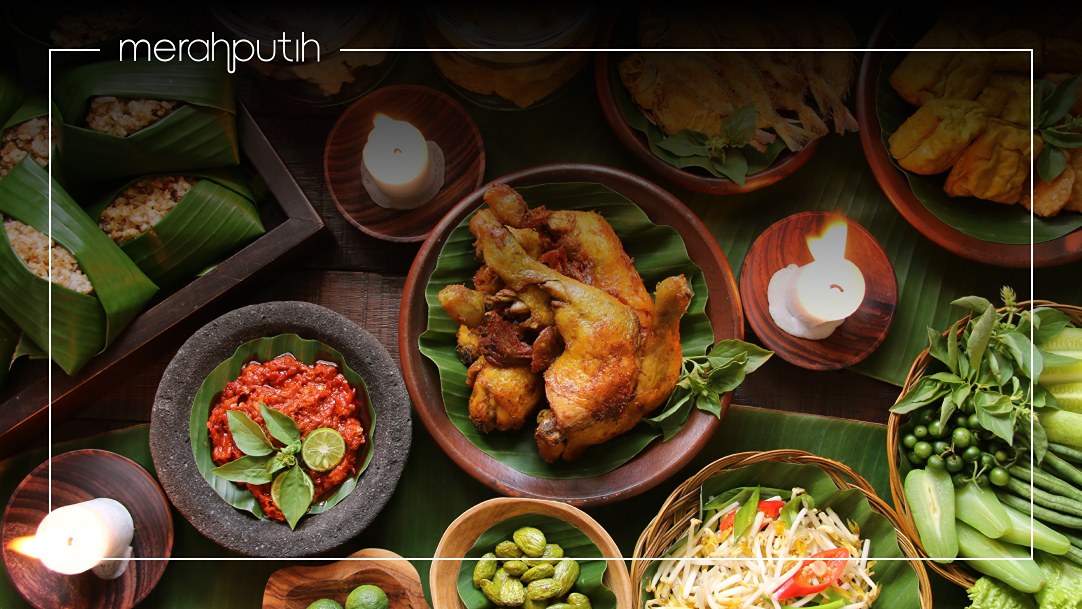Food is a central element of many cultures around the globe. When shared and enjoyed together, it has the power to break down walls and bridge divides.
To the Balinese, food is more than just consumption. It’s an integral part of religious ceremonies, with every element symbolising different aspects of their age-old belief. Additionally, it reflects the greater collectivist culture in Indonesia.
In the island of the gods, “family style” dining takes on a different level with the communal Balinese dining tradition known as megibung.
What is megibung?
In Balinese culture, megibung is a traditional communal meal originating from Karangasem in North Bali.
The word “gibung” means “to share with one another” and perfectly describes this dining custom. A large meal is prepared and set in a circle, with the rice and side dishes laid out on banana leaves. No cutleries are involved as a group of 5 to 8 people gather round in a circle and start digging in with their hands.
This tradition is usually held during events like weddings or religious ceremonies. Temple visits and ngaben cremation ceremonies would involve a large communal meal where the host invites friends and family to the feast, during which the group will also pray that the event go smoothly.
The origins of a communal dining tradition
Megibung was pioneered by the king of Karangasem, I Gusti Agung Anglurah Ketut Karangasem, in 1692.
According to Balinese history, this custom first came to be while the king was on a war expedition in Lombok. One day, he decided to rest and commanded his soldiers to eat together with him in a circle.
The king enjoyed the down time spent with his troops, as in that moment they were no longer separated by status or rank – they were just tired men enjoying a meal. This tradition was then brought back to Karangasem.
How megibung works
The social aspect of this communal eating experience begins before the meal. The Balinese would cook everything together in the kitchen, with different people preparing different elements.
A large portion of rice is laid out on a large tray called gibungan, which is lined with banana leaves. Side dishes such as chicken and vegetables are referred to as karangan.
Social values behind this dining tradition
Beyond merely sharing a meal, this Balinese feast is seen as a way to break down social barriers, as proven by the original story. Everyone eats from the same spread and sits on the floor at the same level with one another.
Megibung also highlights the importance of communal commitment, known as gotong royong in Indonesia, as the meal starts and ends with the community.
Additionally, it’s also an opportunity to share and show respect for one another.
Balinese communal eatingcustoms
It’s basic practice to wash one’s hands before digging into the feast to ensure good hygiene.
Diners should eat the portion directly in front of them. It’s considered disrespectful to reach over and grab food from other people’s side of the banana leaf.
As this is a community affair, it’s also customary that nobody leaves the circle until everyone is full or finished eating.
Experience Balinese culture through food
You can learn much about Balinese culture by exploring its diverse cuisine. Whether you eat anything or have dietary restrictions, love some heat in your food or can’t handle spice at all, there’s something for you to try.
Bali is never short of traditional food—from street vendors to warungs to high end restaurants. If you’re looking for an elevated take on classic Balinese and Indonesian recipes, visit Merah Putih restaurant. This fine dining establishment offers exquisite dishes paired with signature cocktails and wines from around the world.
Book a table and claim these exclusive gift vouchers today.
FAQ
In Balinese culture, megibung is a traditional communal meal originating from Karangasem in North Bali. A large meal is prepared and set in a circle, with the rice and side dishes laid out on banana leaves. No cutleries are involved as a group of 5 to 8 people gather round in a circle and start digging in with their hands.
The Balinese uphold many traditions manifested in religious ceremonies throughout the year. Food is almost always an integral part of these rituals. One such food-related tradition is megibung, a traditional communal meal where everyone eats from a central spread of rice and side dishes.
Beyond merely sharing a meal, this Balinese feast is seen as a way to break down social barriers. Everyone eats from the same spread and sits on the floor at the same level with one another. Megibung also highlights the importance of communal commitment, known as gotong royong in Indonesia, as the meal starts and ends with the community. Additionally, it’s also an opportunity to share and show respect for one another.
